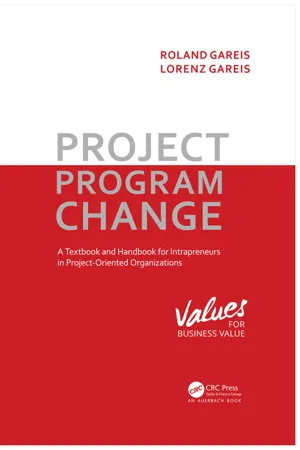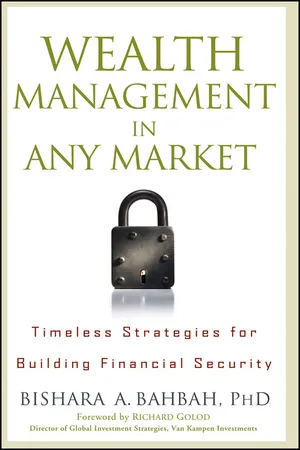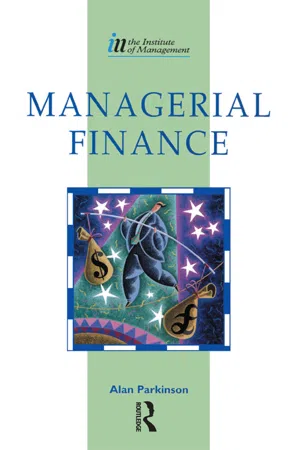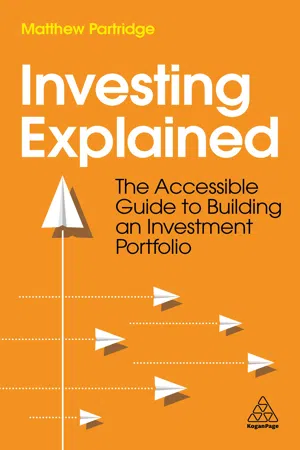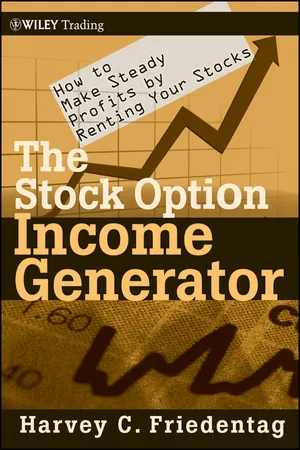Business
Investments
Investments refer to the allocation of resources, typically money, with the expectation of generating future income or profit. In a business context, investments can include purchasing stocks, bonds, real estate, or other assets with the goal of achieving long-term financial growth. Effective investment strategies are crucial for businesses to maximize returns and achieve their financial objectives.
Written by Perlego with AI-assistance
Related key terms
6 Key excerpts on "Investments"
- eBook - ePub
- Roland Gareis, Lorenz Gareis(Authors)
- 2018(Publication Date)
- Taylor & Francis(Publisher)
Investments may relate to various objects—namely, to a product or service, a market, the organization, the personnel, the infrastructure, the financing, and a stakeholder relation. Therefore, unlike in accounting, the definition of an investment used here is not limited to depreciable fixed assets.Definition: InvestmentAn investment is defined as a chain of business processes required to ensure an organization’s capacity to provide services. A differentiation may be made between product or service-related Investments, market-related, organization-related, personnel-related, infrastructure-related, financing-related, and stakeholder-related Investments.Investment Types
In accordance with the structural and contextual dimensions of organizations defined above, investment types can be differentiated as follows:- product or service-related Investments (e.g., developing and selling a product),
- market-related Investments (e.g., developing and serving a market),
- organization-related Investments (e.g., developing and using an organization),
- personnel-related Investments (e.g., developing and deploying personnel),
- infrastructure-related Investments (e.g., developing and operating ICT infrastructure),
- finance-related Investments (e.g., an initial public offering), and
- stakeholder-related Investments (e.g., developing and using a supplier relation).
The general life cycle of an investment object includes the phases of planning, implementing, operating or using, and any subsequent decommissioning of an investment object. The life cycle of an investment object begins once the investment decision is taken. The life cycle of an industrial plant, for example, includes the following chain of business processes: “constructing the industrial plant”, “operating the industrial plant”, “maintaining the industrial plant”, and “decommissioning the industrial plant”. The upstream business process “conceptualizing the industrial plant investment” provides a temporal context for this investment.Fig. 3.4 - eBook - ePub
Wealth Management in Any Market
Timeless Strategies for Building Financial Security
- Bishara A. Bahbah(Author)
- 2009(Publication Date)
- Wiley(Publisher)
Investing is the placement of money into a financial vehicle with the objective of making a profit. Investment can be achieved through ownership, loaning money, derivatives, and paying off costly debt. There are numerous financial instruments/vehicles that facilitate your investing. The most common of these are mutual funds (open- and closed-end funds), index funds, unit investment trusts, exchange trade-funds, and separately managed accounts.The Six Ways to Achieve Investment
Investing can be achieved six ways:1. Ownership, such as buying a stock or real estate2. Loaning money to an entity such a corporation or the government3. Interest-bearing instruments, such as checking and savings accounts, and certificates of deposit (CDs)4. Derivatives, buying options or futures contracts5. Alternative Investments6. Paying off costly debtINVESTING THROUGH OWNERSHIP Companies use stocks to raise capital to get started or help sustain the growth of a business through marketing, adding new products, or even acquiring new businesses. As a stockholder, you become one of the owners of that company, no matter how small your piece of the pie may be. This is the reason stocks are considered equity Investments. Common stocks provide a share of ownership in a company and provide the shareholder with a right to vote in company issues. The price of a share of stock will vary dramatically among companies, from pennies to hundreds or thousands of dollars, depending on a large of number of factors such as held assets, market share, profitability, price to earnings ratio, and so on. Stocks, especially individually held stocks, are regarded as one of the riskiest Investments. By comparison, preferred stocks often yield higher and more stable dividends. Dividends - eBook - ePub
Return on Investment Manual
Tools and Applications for Managing Financial Results
- Robert Rachlin(Author)
- 2019(Publication Date)
- Routledge(Publisher)
Many capital Investments tie in with the future plans of the company. These plans anticipate growth, recovery of resources, and directions that a company must take to succeed in a given economic environment. Sometimes, a shift of emphasis is placed on the direction through certain investment opportunities. The ability to project the future becomes more and more difficult.In addition to the support of top management, other key elements go into the success or failure of a capital investment. They center on the ability of top management to time the capital investment in such a way that maximizes the benefits expected for the project. Timing is a vital ingredient to the success or failure of most capital Investments. Not only is it important for the acquisition of machinery and equipment but also for Investments in working capital. Knowing when to tighten up on accounts receivable and add inventory and what cash balances to maintain are all important questions that revolve around timing.Top management must also give clearly defined directions and make sure that the entire capital process is adequately coordinated throughout the company.The capital investment process involves investing in many different areas of the company. It may require Investments in a functional activity of a company, such as to support the sales effort, production requirements, distribution, or administrative needs. There are usually no guidelines as to how much is spent on functional activities of the company. As long as funds can be made available, and justification can be supported, Investments in these areas are usually made.There are many different types of Investments in assets. But such Investments can be categorized into three major areas: physical assets, working capital, and research projects.Types of Asset Investments
- eBook - ePub
- Alan Parkinson(Author)
- 2012(Publication Date)
- Routledge(Publisher)
The significance of the capital investment decision is thus clear. The reasons rationalizing the significance apply to longer term investment decisions in general although their degree of significance, and thus their degree of influence upon decision-making, will vary according to the particular type of decision and organizational activity being looked at. A common feature that all capital budgeting decisions have with shorter term Investments is that managers are looking at making Investments which will (hopefully!) produce returns. The distinction is that the longer term investment decision will produce returns over a number of future time periods rather than the current period returns which arise from other types of decisions.Capital investment decisions will generally be concerned with the planning for and management of activities such as:- the acquisition of fixed assets such as land and buildings, plant and equipment and vehicles (be it a first-time or replacement acquisition)
- investment in a special project such as a marketing/advertising campaign or research and development
- the expansion of current facilities, be they production or administrative or in relation to any other
- entry into new product/service provision
- investment in development of managers, such as yourself, through training and education.
Such investment decisions are never easy Often, given the long-term nature of the decision consequences, the projected outcomes and associated returns are at best uncertain and at worst unpredictable and/ or intangible. Given this scenario it is understandable that many managers seek advice from all quarters as an aid to reducing the risk of making the wrong capital investment decisions. What they invariably seek is a framework, at least from a financial angle.A framework for predicting the future
If you as a manager had the opportunity to design an appropriate advisory framework from scratch, it is likely that you would wish the design to help you to solve certain key problems which might hamper your effective decision-making. Perhaps the two key problems needing remedies might be: - eBook - ePub
Investing Explained
The Accessible Guide to Building an Investment Portfolio
- Matthew Partridge(Author)
- 2022(Publication Date)
- Kogan Page(Publisher)
01The basics of investing
SummaryInvesting is putting your money to work so that it grows. To do this you need to work out your financial goals, sort out your finances so you can start saving regular amounts of money and then start investing it in assets like shares and bonds (with the balance between the two depending on your investment horizon). Over time, such a strategy should ensure that you can accumulate sufficient money to more than meet your needs. This is particularly important in the case of retirement because, with firms providing less generous pensions, and governments around the world constantly increasing the retirement age, you will need to take responsibility for your financial future.1. Why do I need to bother with investing?
Whenever I reveal to people that I’m a financial journalist, I get one of three reactions.Some people try and get me to reveal the secret of making a fortune in the stock market. Others start ranting about their bank, or the latest financial scandal, as if I’m responsible. Finally, some people’s eyes glaze over and they politely say ‘that sounds interesting’ before changing the subject. (Though one person has been blunt enough to simply say, ‘What a boring job.’)Obviously, I don’t agree with this last sentiment, since I find following the twists and turns in the financial markets fascinating. But it’s true that, to quote Nicholas Cage in Matchstick Men, ‘For many people, money is a foreign film without subtitles.’ And there’s nothing wrong with that. However, there’s no escaping the fact that sticking your head in the sand about money isn’t an option in today’s world.Unless you’re planning on living like a monk, you will have financial goals. That could be to enjoy a comfortable retirement, or to buy a house, or to go travelling, or to pay for school fees (or all of the above). And if you want to meet those financial goals, there’s no way round it: we have to make our money work for us. - eBook - ePub
The Stock Option Income Generator
How To Make Steady Profits by Renting Your Stocks
- Harvey C. Friedentag(Author)
- 2009(Publication Date)
- Wiley(Publisher)
CHAPTER 3An Overview of How to InvestIf you bet on a horse, that’s gambling. If you bet you can make three spades, that’s entertainment. If you bet cotton will go up three points, that’s business. See the difference?—Blackie SherrodLet’s begin with some cautionary words:• The stock market is not for your first or last dollars. • You should provide for emergencies and have adequate insurance and savings for everyday needs. • Provide first for today. Investing is for tomorrow. • Security investing is tomorrow’s security.The first step in establishing an investment plan is to have an emergency fund adequate enough to cover a minimum of three to six months of living expenses. You should accumulate this money in a savings or money market account, or in a checking account that pays interest. These forms of savings vehicles are liquid, which means you can withdraw your money from them whenever you need it without paying a penalty for the withdrawal. Once you have this base covered, you can move on to more sophisticated Investments.One of the biggest causes of losses in stocks is having to sell because you need the invested sums. Money invested in the stock market may not be ready for you to take out when you must have it. Stock market Investments are long-term, usually a five-year time commitment.When it comes to making investment decisions, the first line of defense is a skeptical investor. As the old adage goes, “If it sounds too good to be true, it probably is.”In preparing your investment plan, you need to reflect on your income and growth objectives, your tolerance for risk, and your personal investment preference. Some Investments do more for your money than others. And obviously, some Investments do less for your money than others—sometimes dramatically less.Most low-risk Investments lock you in or limit you to a fixed rate of return. Higher-risk Investments offer possible higher returns. There are money market funds, annuities, mutual funds, government securities, government agencies, certificates of deposit, Treasury bills (T-bills), growth stocks, high-yield stocks, blue chip stocks, corporate bonds, convertible bonds, discount bonds, high-yield bonds, options, corporate income trusts, real estate limited partnerships, and so on. Every day, it seems, someone is calling me with yet another investment opportunity.
Index pages curate the most relevant extracts from our library of academic textbooks. They’ve been created using an in-house natural language model (NLM), each adding context and meaning to key research topics.
